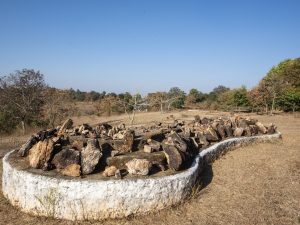Tucked away in the quiet corners of Dindori district, between wildlife giants Kanha and Bandhavgarh, lies a place that literally takes you back 65 million years — to a time when dinosaurs roamed the Earth and tropical forests covered Central India. Nestled in the scenic landscapes of Madhya Pradesh, the Ghughua Fossil National Park stands as a remarkable testament to Earth’s ancient botanical heritage. An Unearthed Treasure of 65 Million Years This exclusive fossil park is home to plant fossils that date back approximately 65 million years, spanning from the Upper Cretaceous to the early Tertiary period—a critical phase in Earth’s vegetational evolution. These fossils belong predominantly to dicotyledons and palm families, including rare species such as ancient Eucalyptus, indigenous to Australia, which offers compelling evidence of the legendary Gondwana Supercontinent that once connected the southern landmasses. The park’s collection comprises exquisitely preserved fossils of woody plants, climbers, leaves, flowers, fruits, and seeds. Notable among these are fossilized remnants of Date Palm, Jamun, Banana, Rudraksh, and Aonla, plants that narrate a vivid story of a dramatically different prehistoric climate in Central India—one that was far more humid and lush than today’s dry terrain. Historical Discovery and Scientific Significance The discovery of these invaluable fossils traces back to 1970, when Dr. Dharmendra Prasad, then Statistical Officer of Mandla district and honorary secretary of the District Archaeology Union, first identified these plant fossils. Collaborating with eminent paleobotanists such as Dr. M.B. Bande from the Birbal Sahni Institute of Paleobotany, Lucknow, and scientists from Jabalpur’s Science College, the fossils were scientifically analyzed and catalogued. This pioneering work elevated the region to the global fossil map, attracting scientists, researchers, students, and tourists alike. Recognizing the …
Read More »
Breaking News
- Tour Blue Holdings Awarded GOOD TRAVEL SEAL, Joins Travelife, and Expands to Northern Sri Lanka with New Jaffna Office
- Anantara Jewel Bagh Jaipur hosts excusive evening in Delhi, plans to expand focus to FIT, MICE & corporate
- Thailand sees 30% increase in flights from India compared to last year
- BaliTrip Wisata to add Sri Lanka and the Philippines to its portfolio from October
- Himachal plans new tourism council to fast-track big projects, attract investment
- India, Japan drive APAC resilience despite global slowdown: GlobalData
- T Syndicate hosts independence-themed travel industry meet in Mumbai
- Malaysia Airlines to Malaysia launch daily flights to Trivandrum by Dec
- Tripura to set up 6 eco-parks, looking to boost tourism in state
- ITC expands North India presence, signs Fortune Hotel, Lucknow
- Kerala to launch first-ever low-interest loan soon to empower women in tourism
 Tourism Breaking News
Tourism Breaking News
